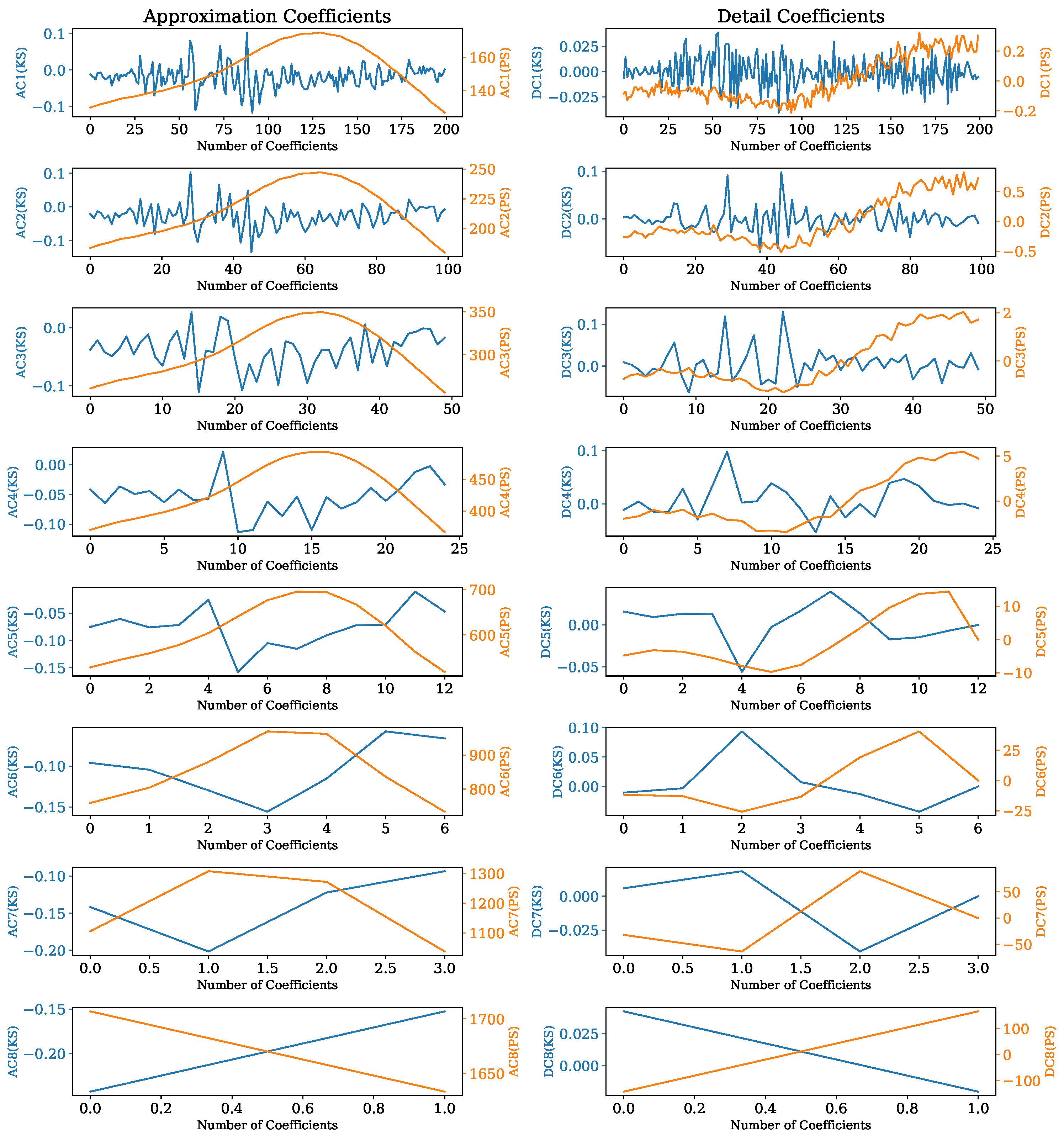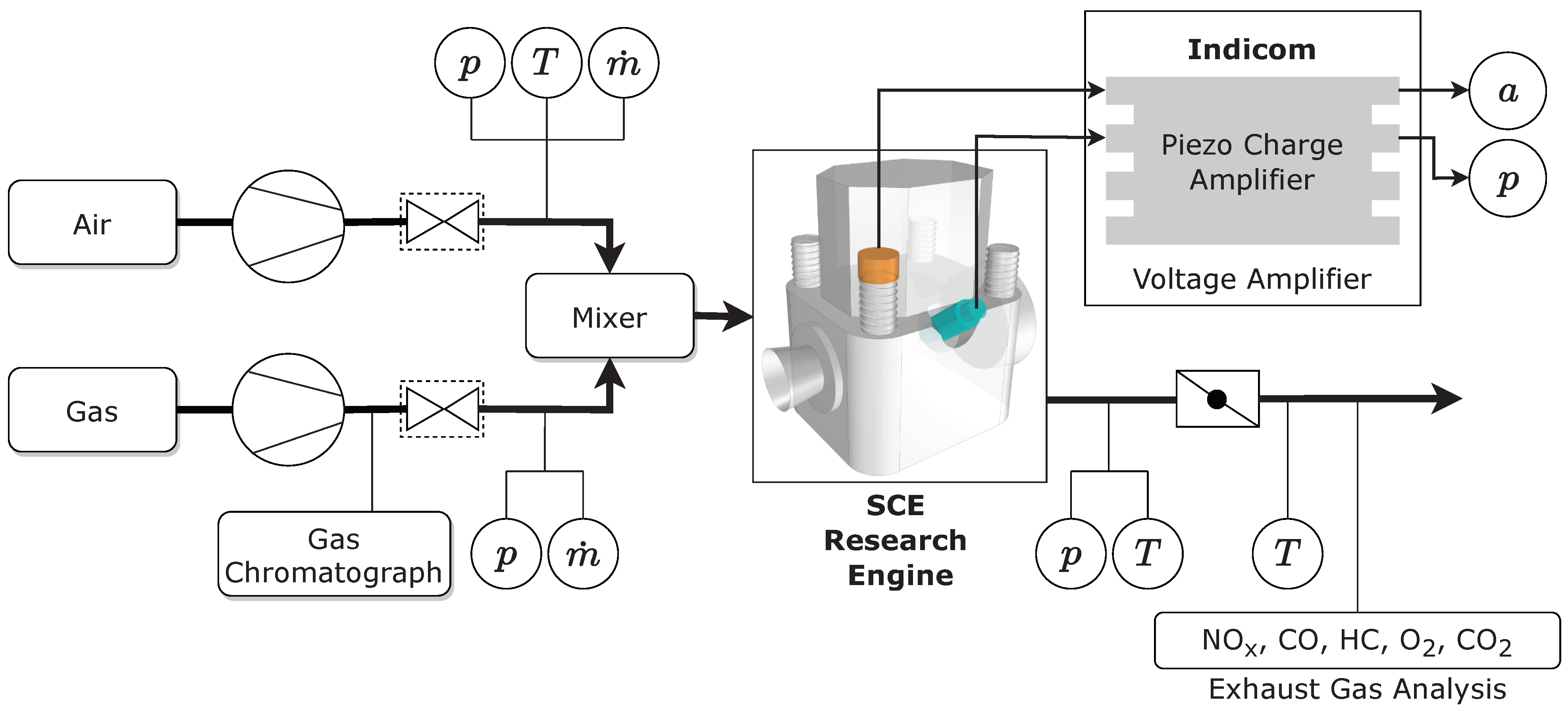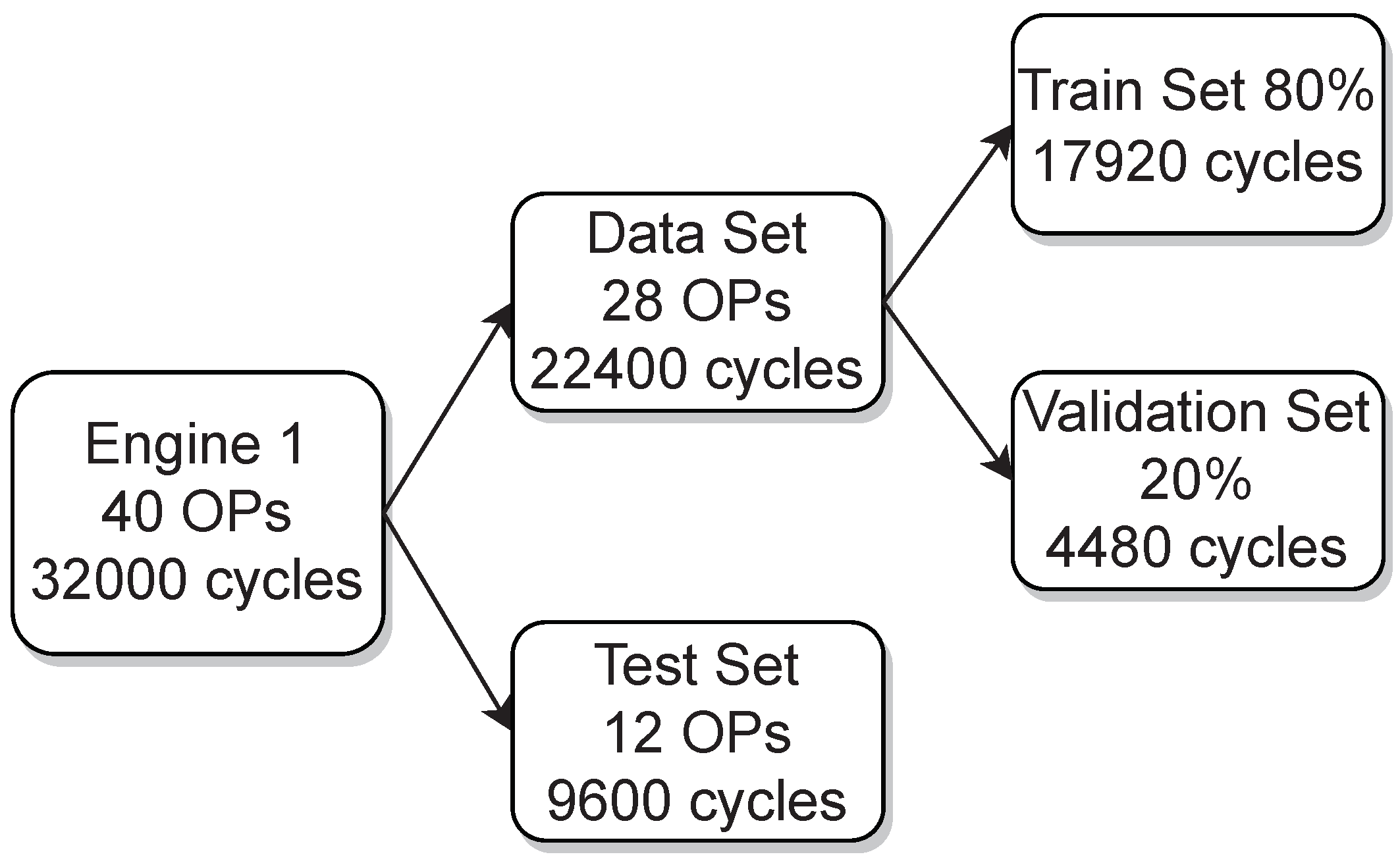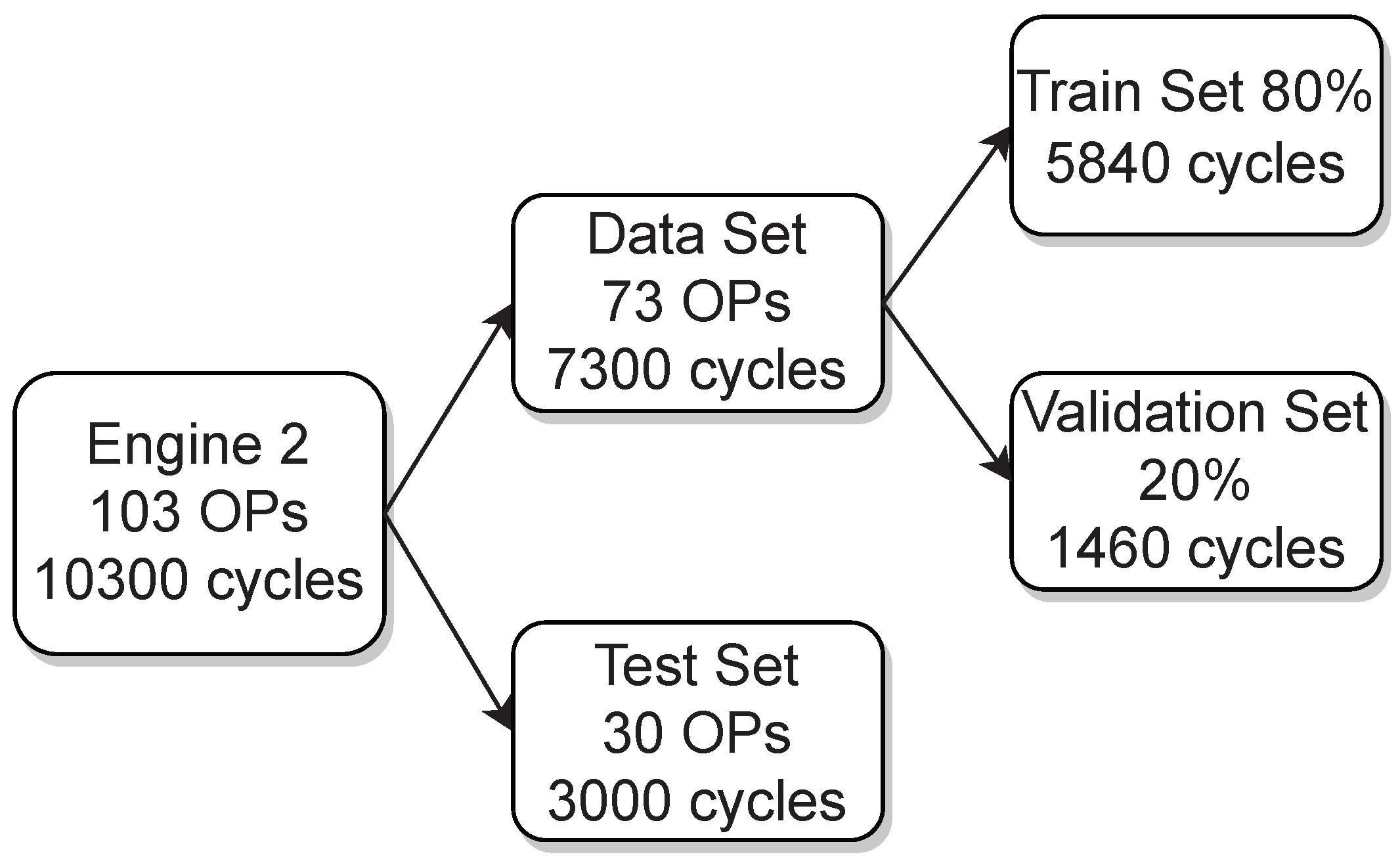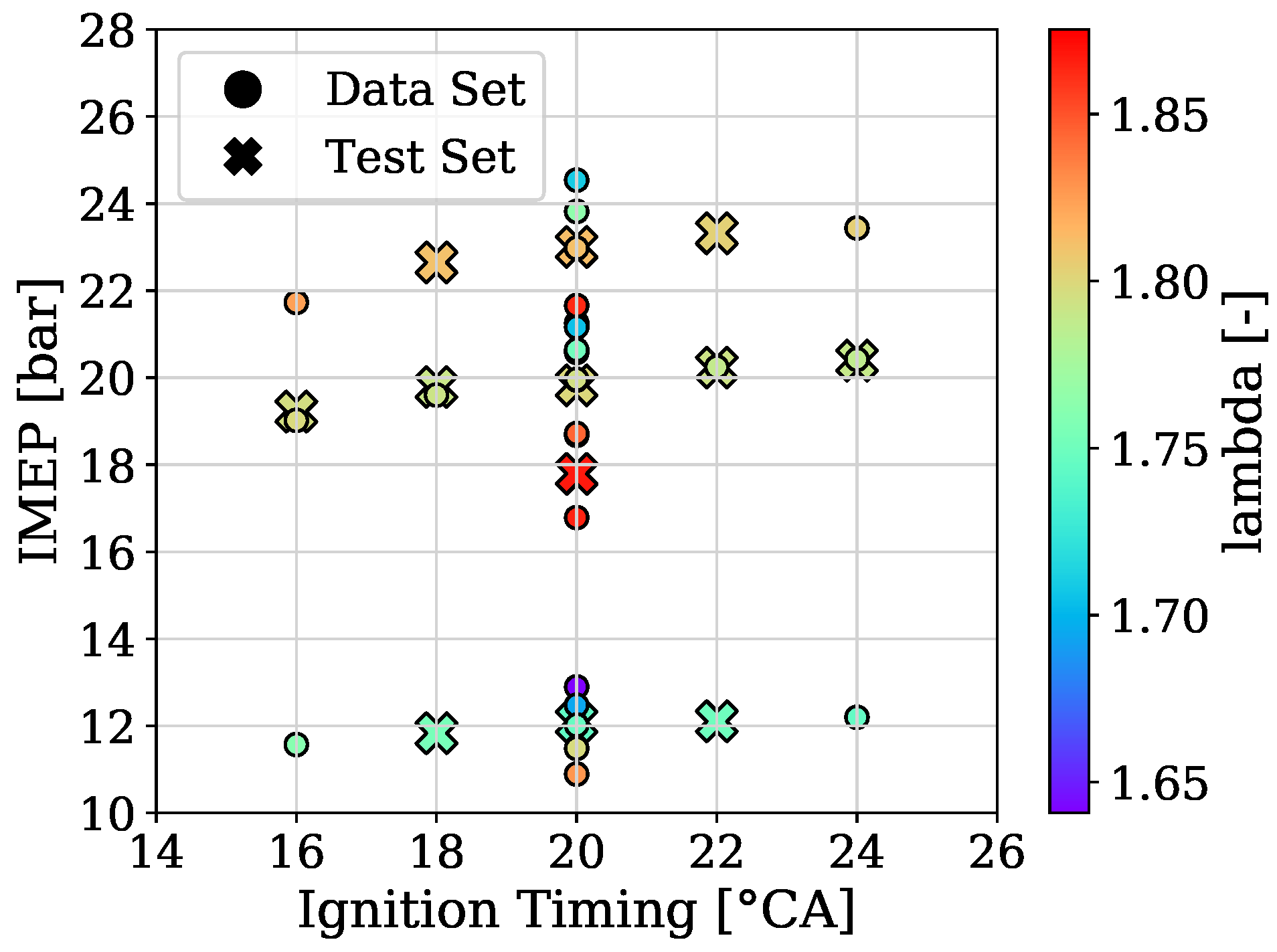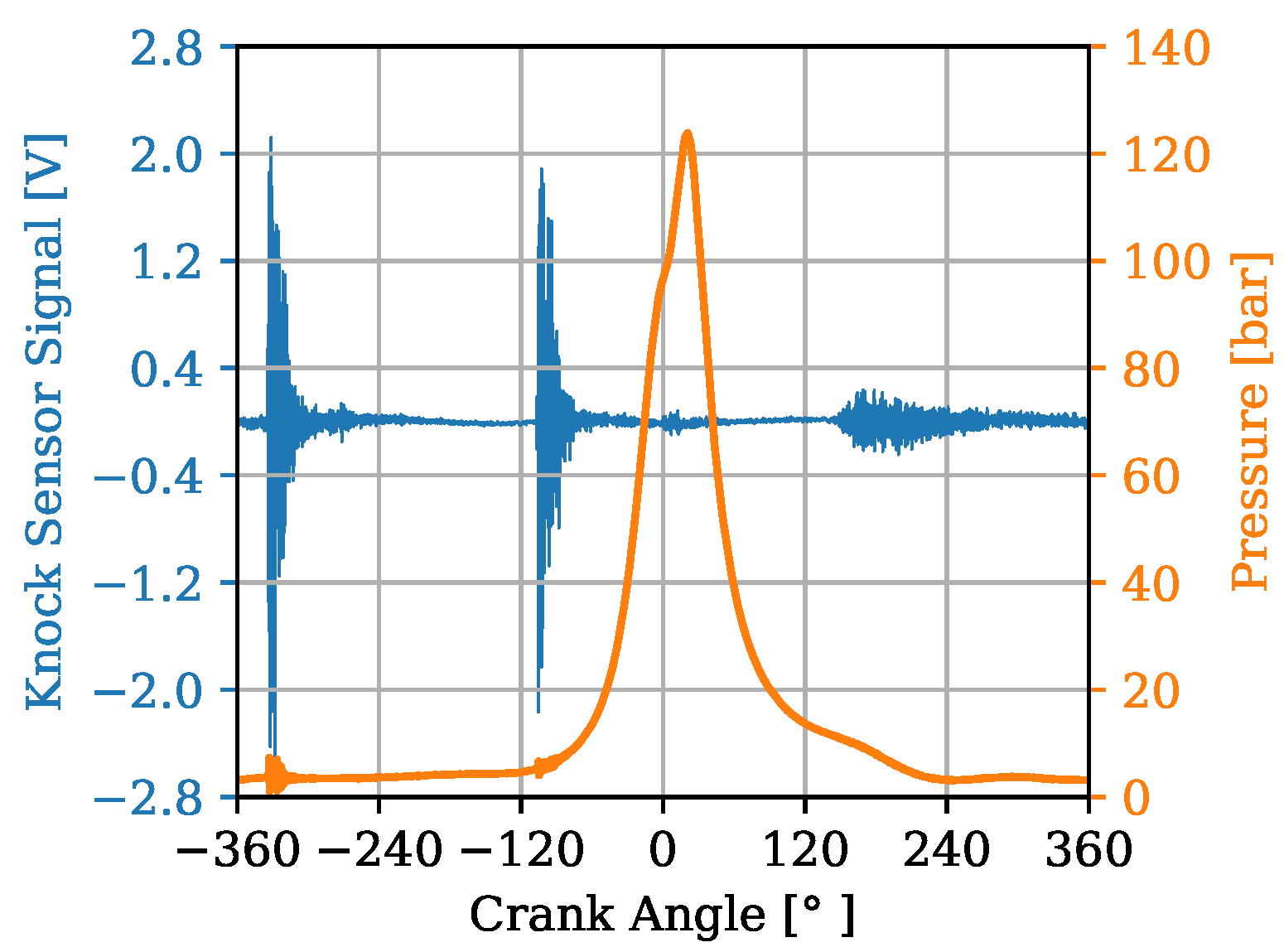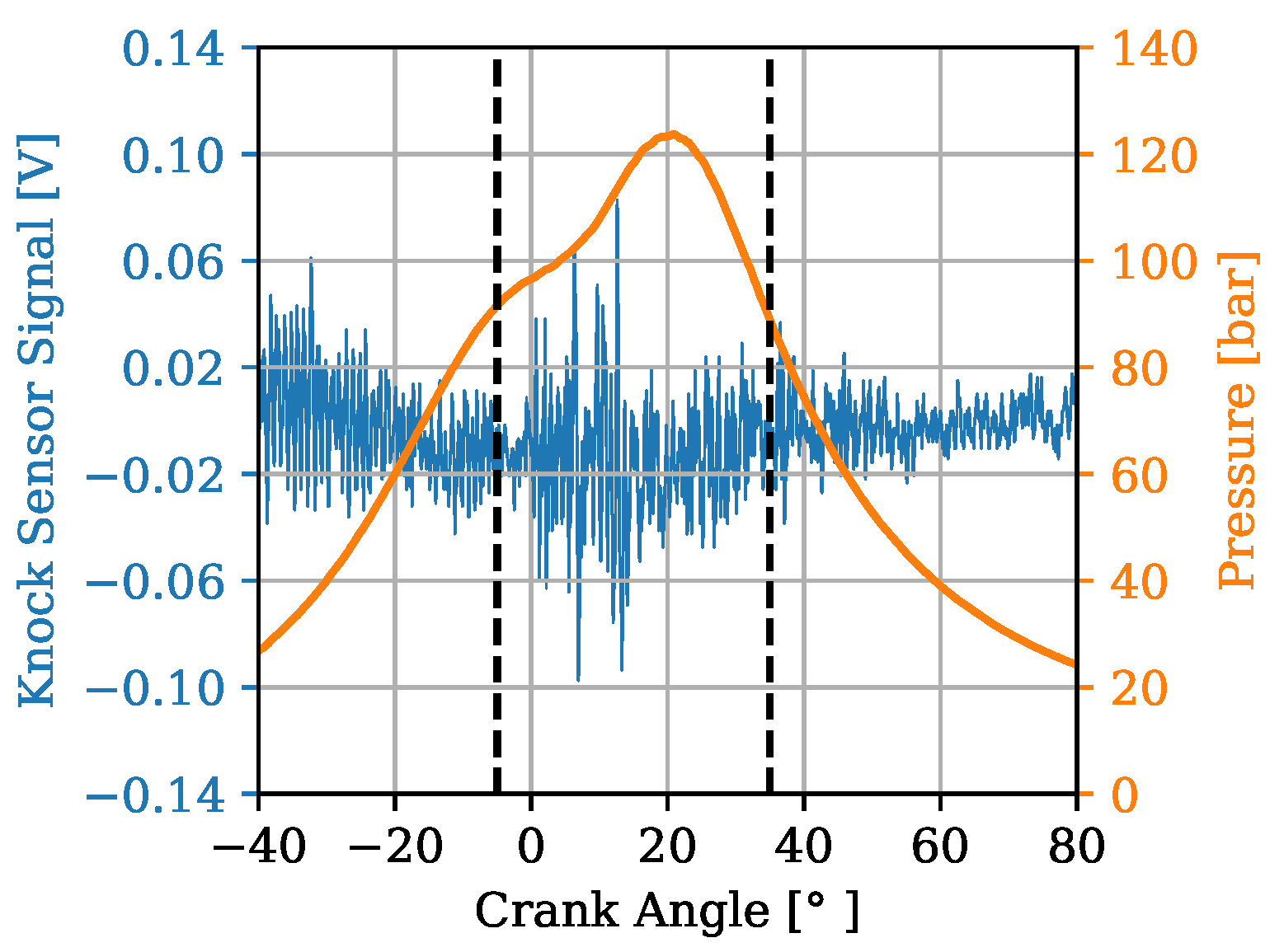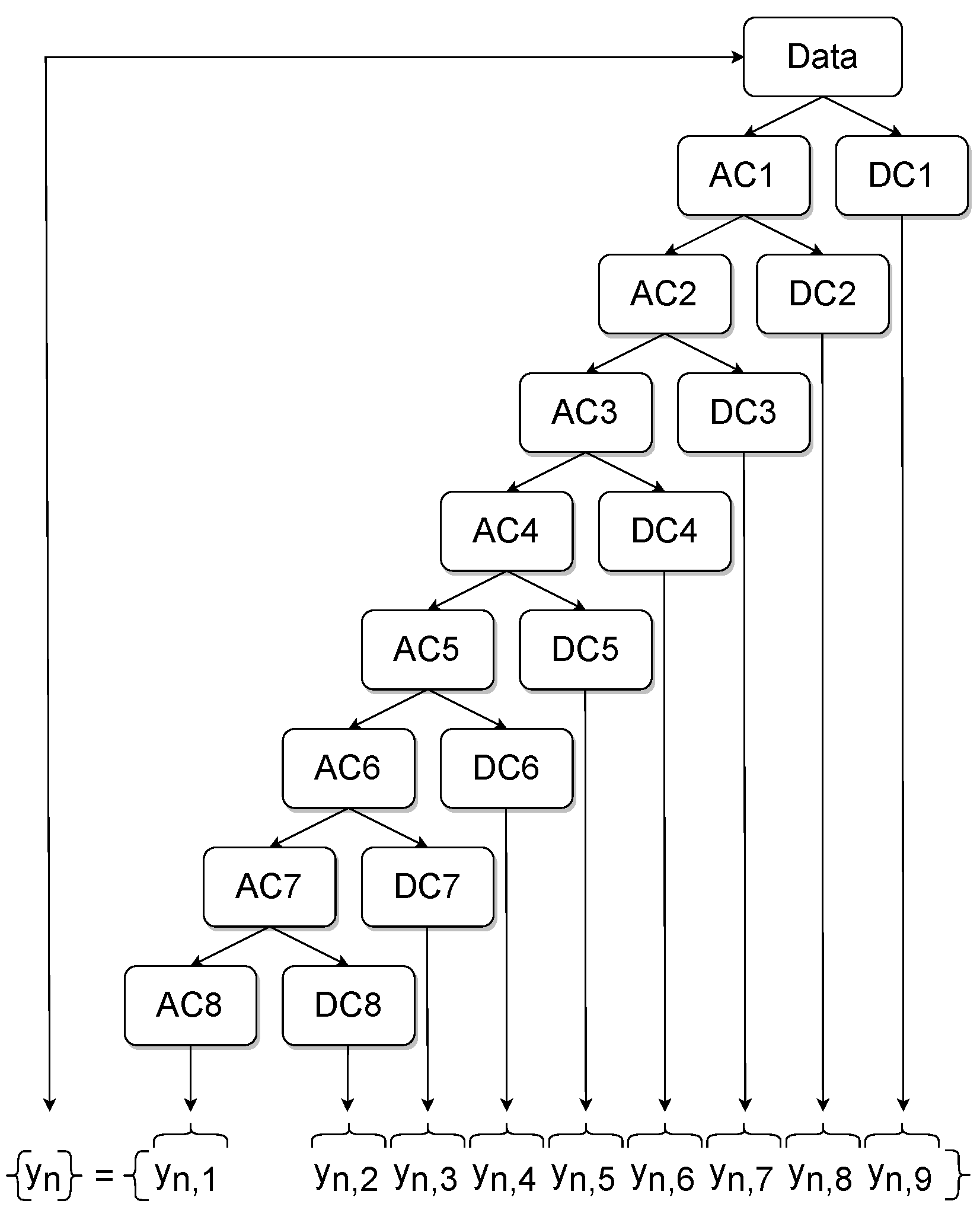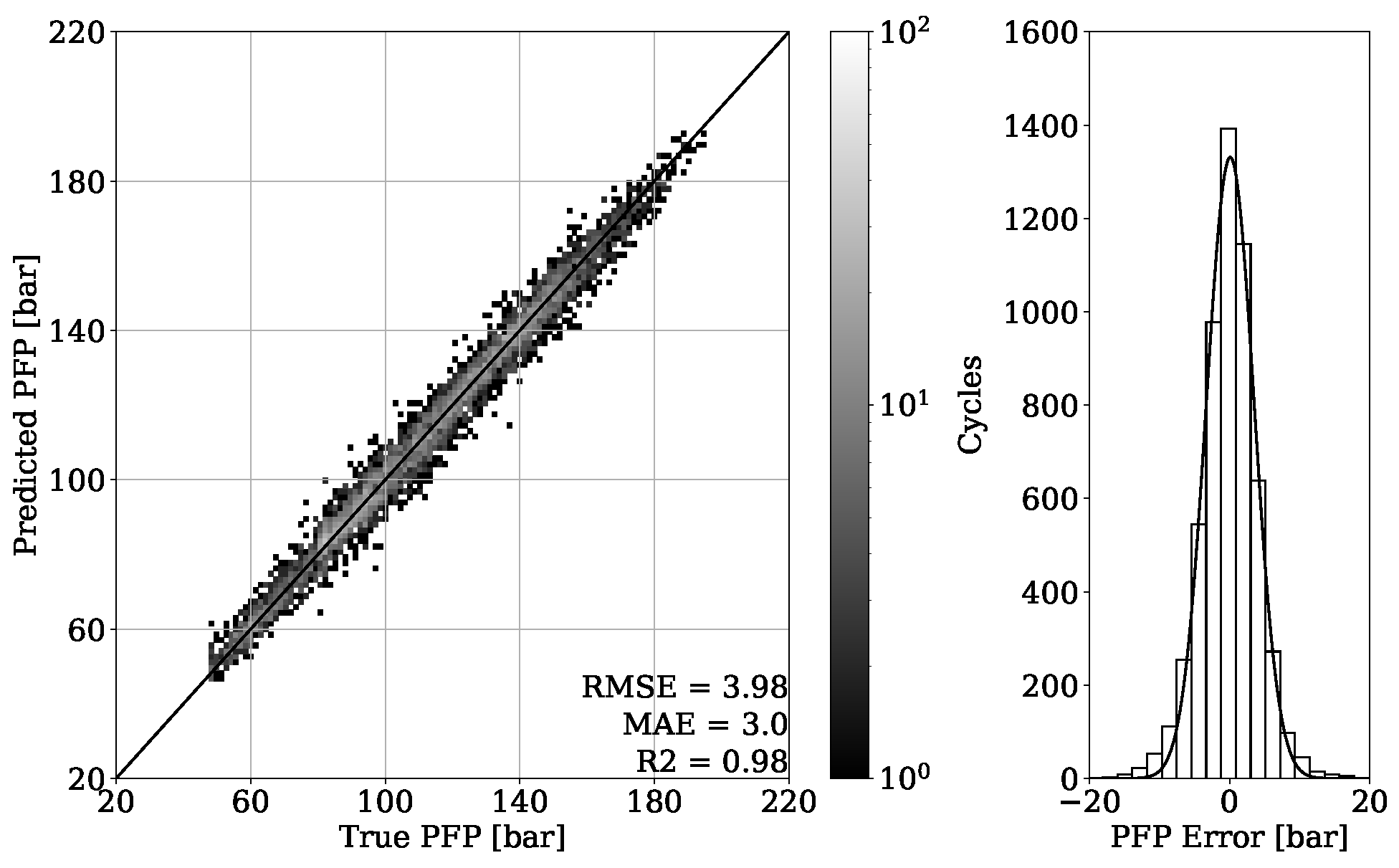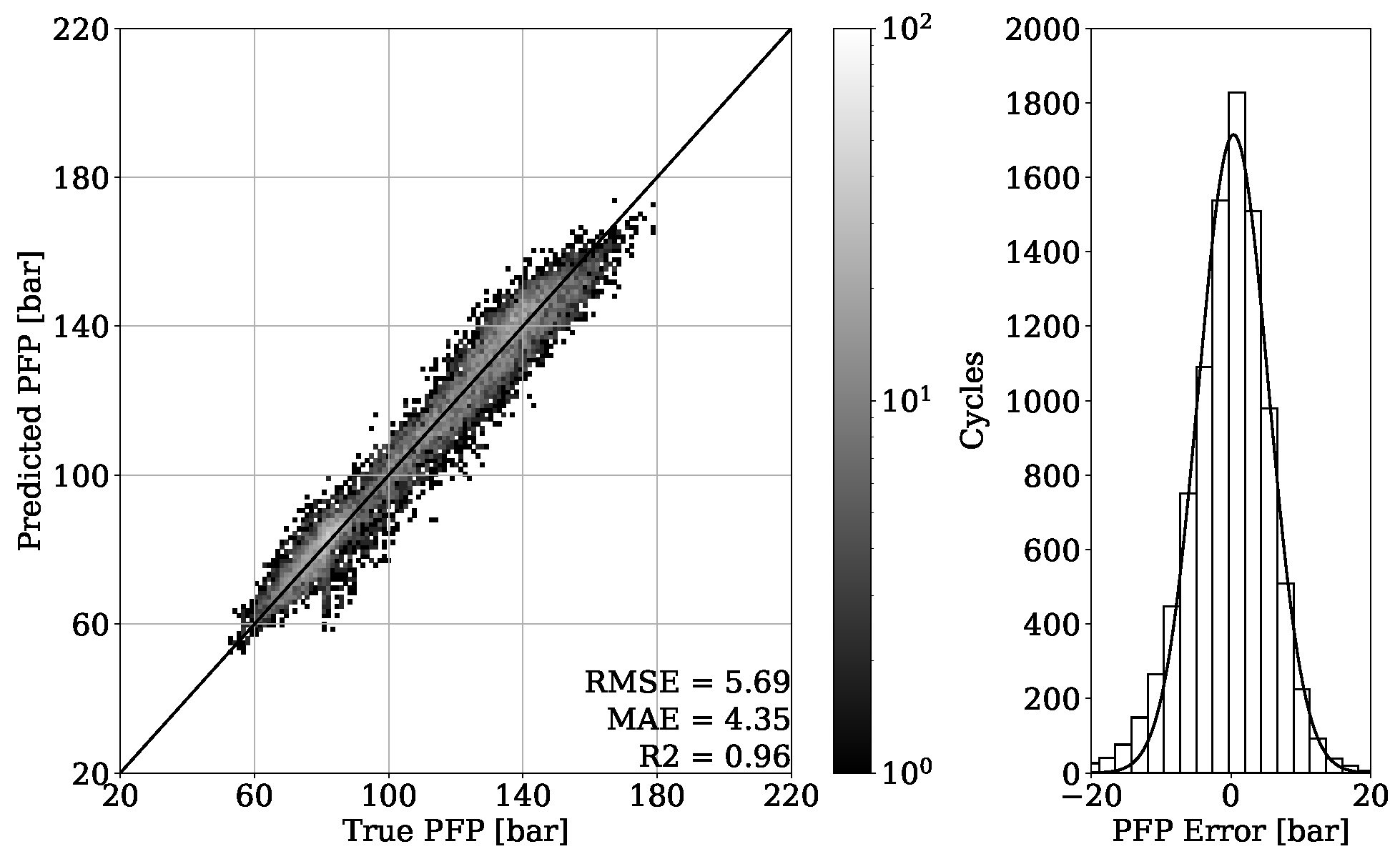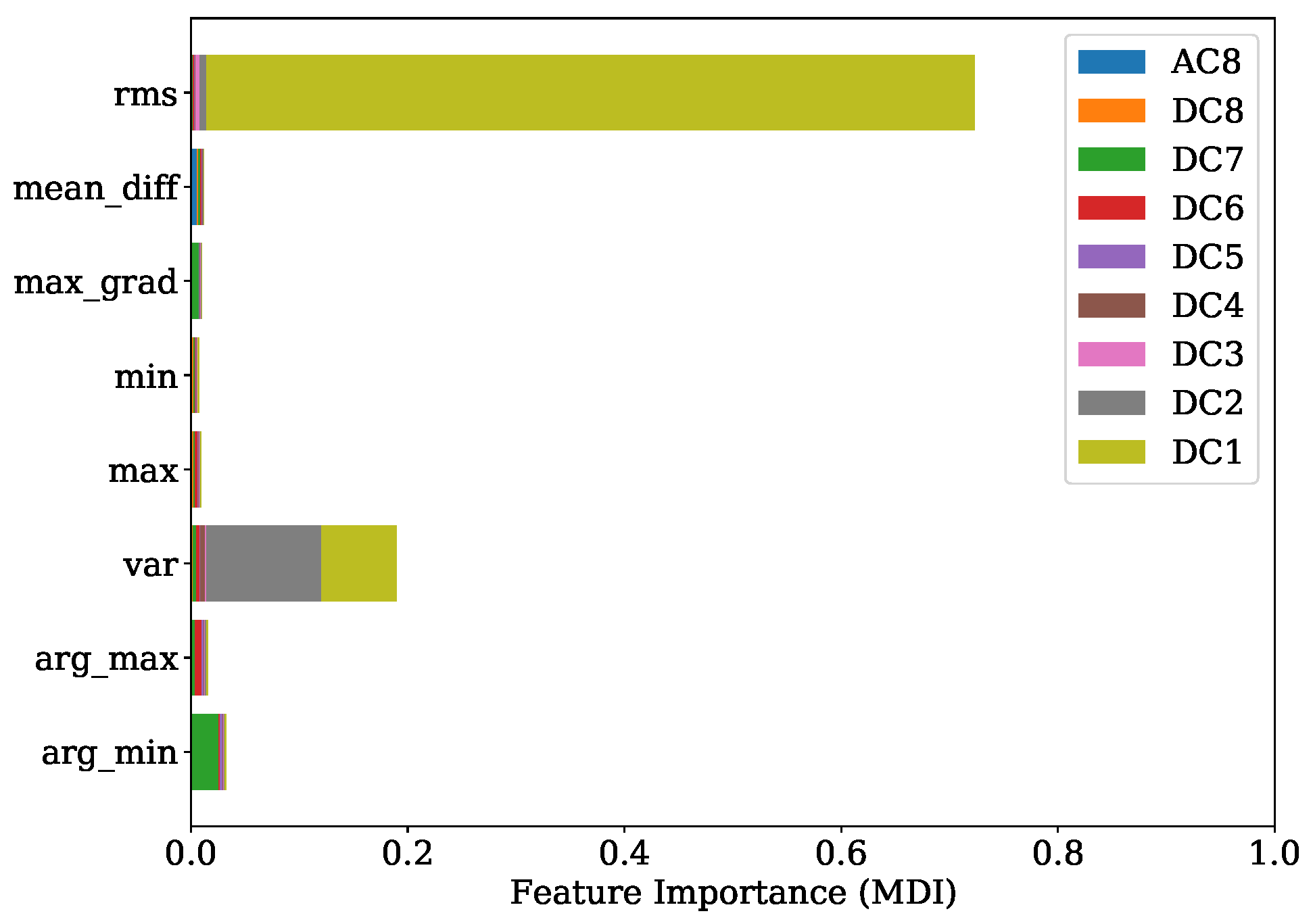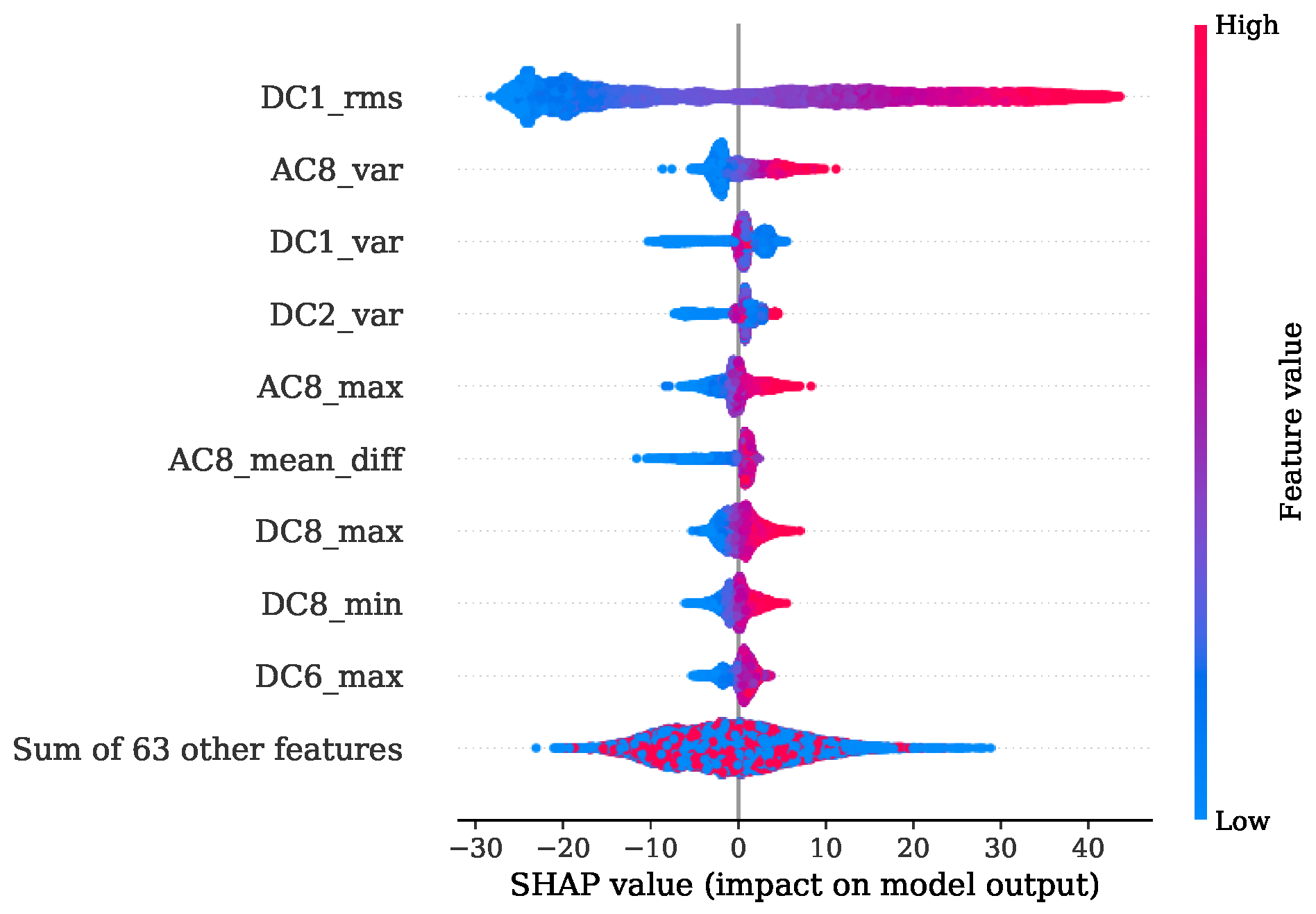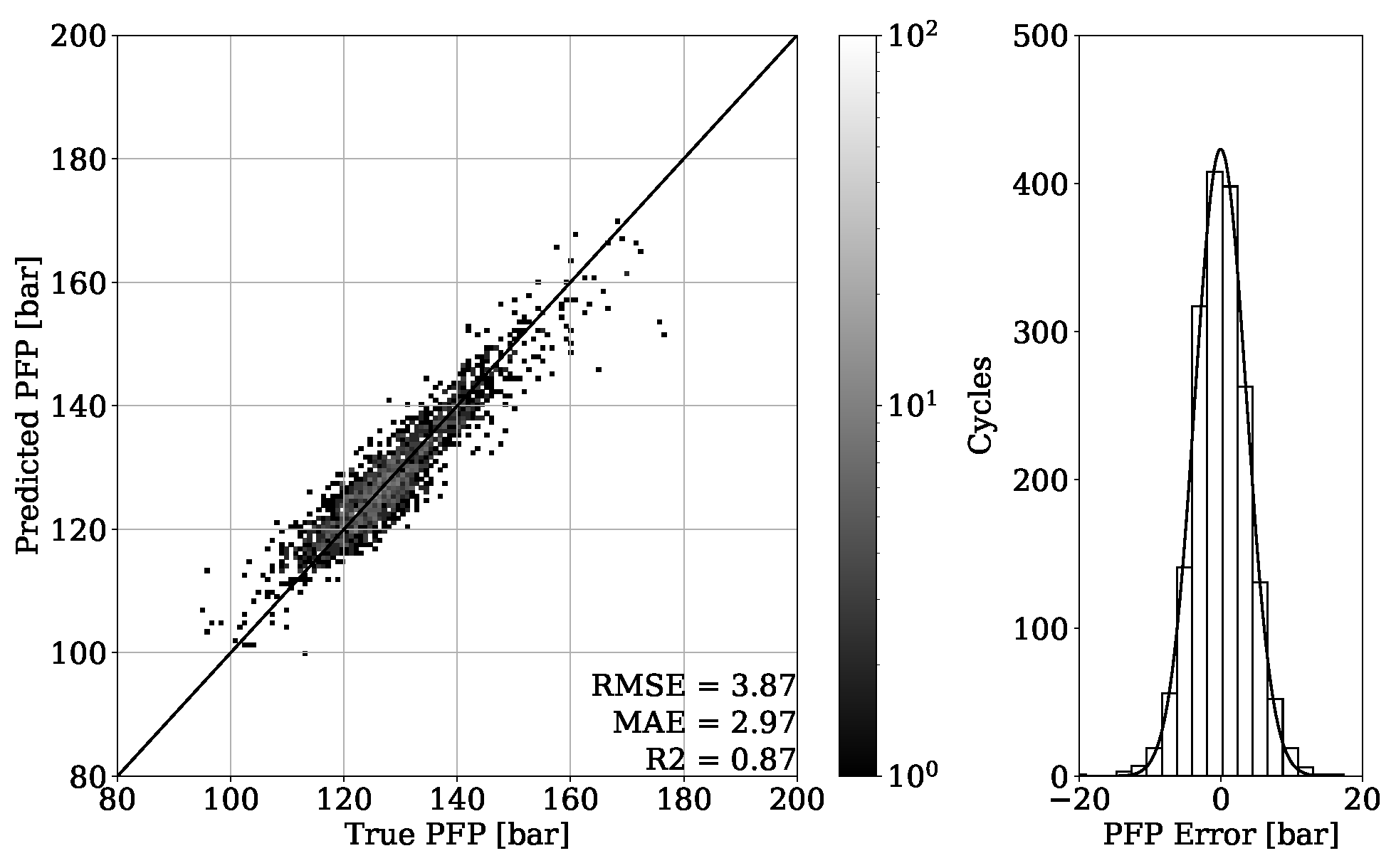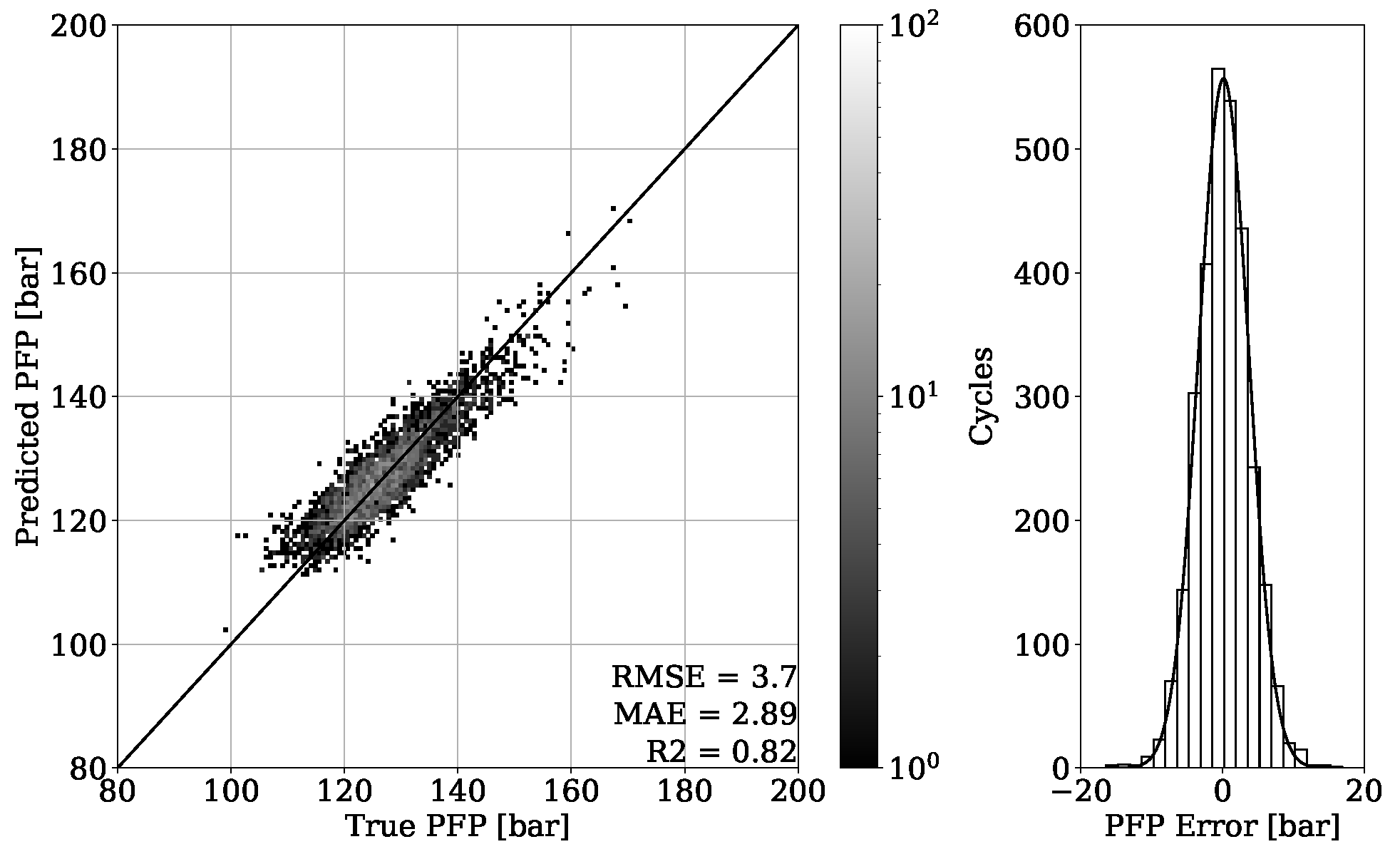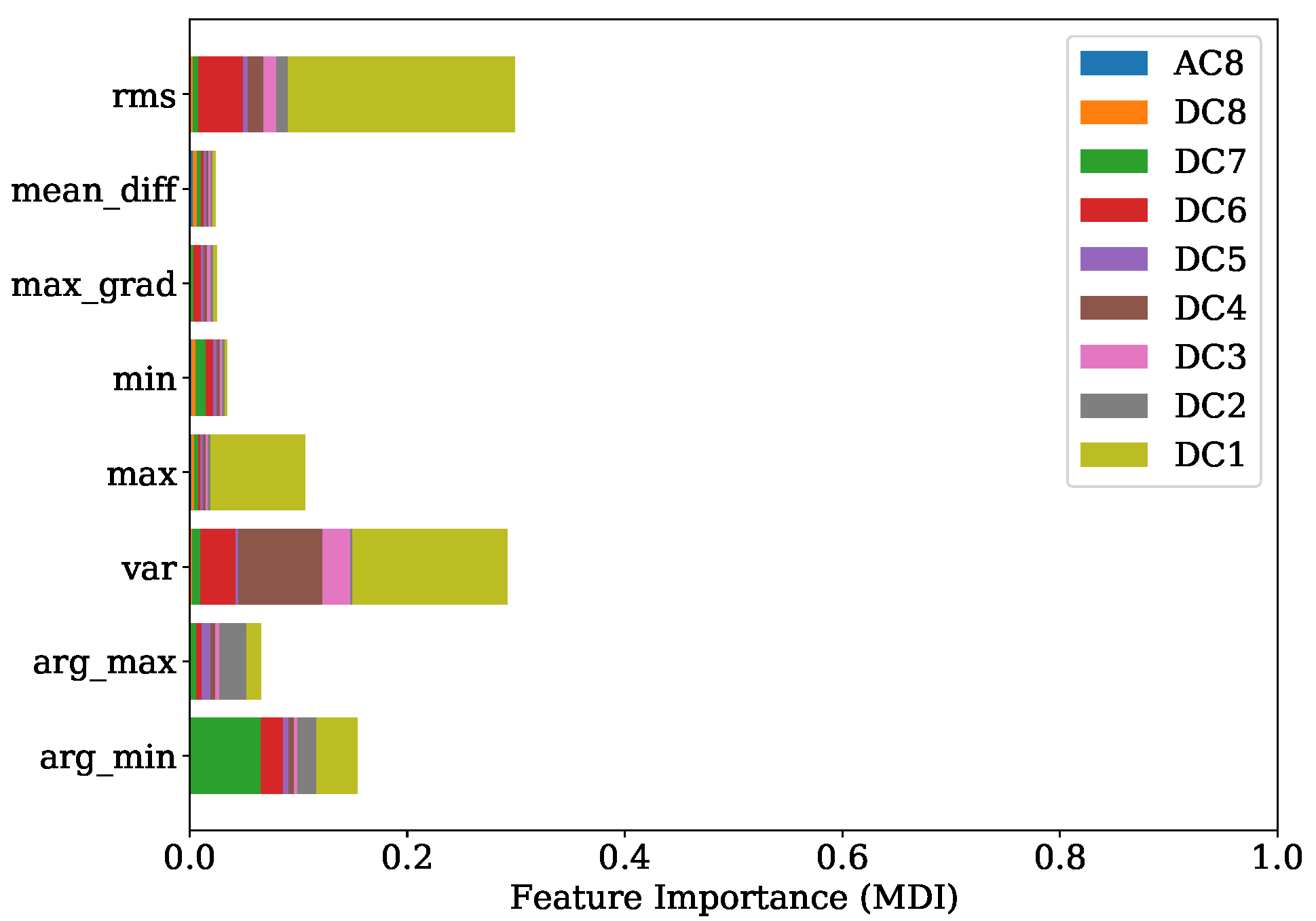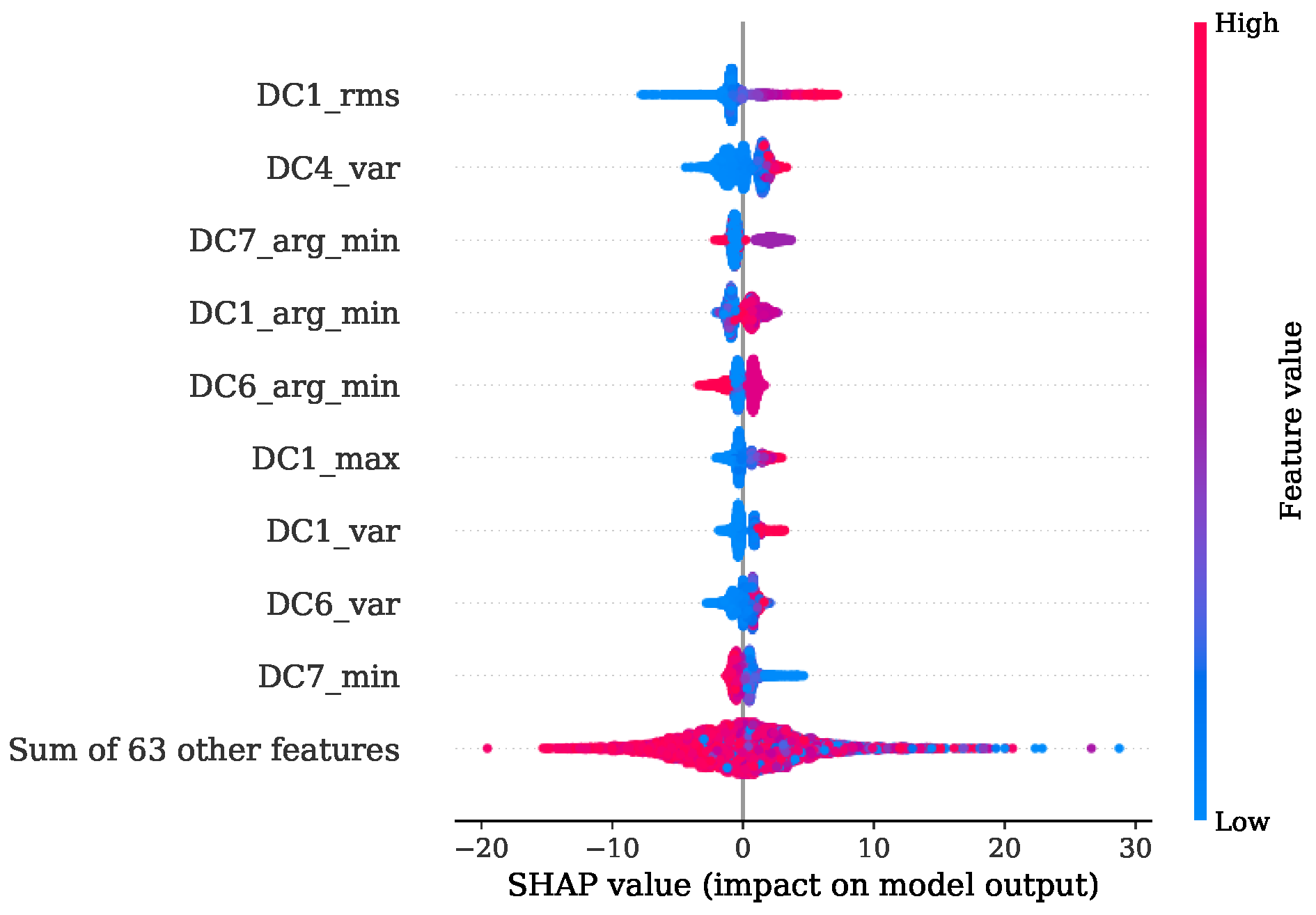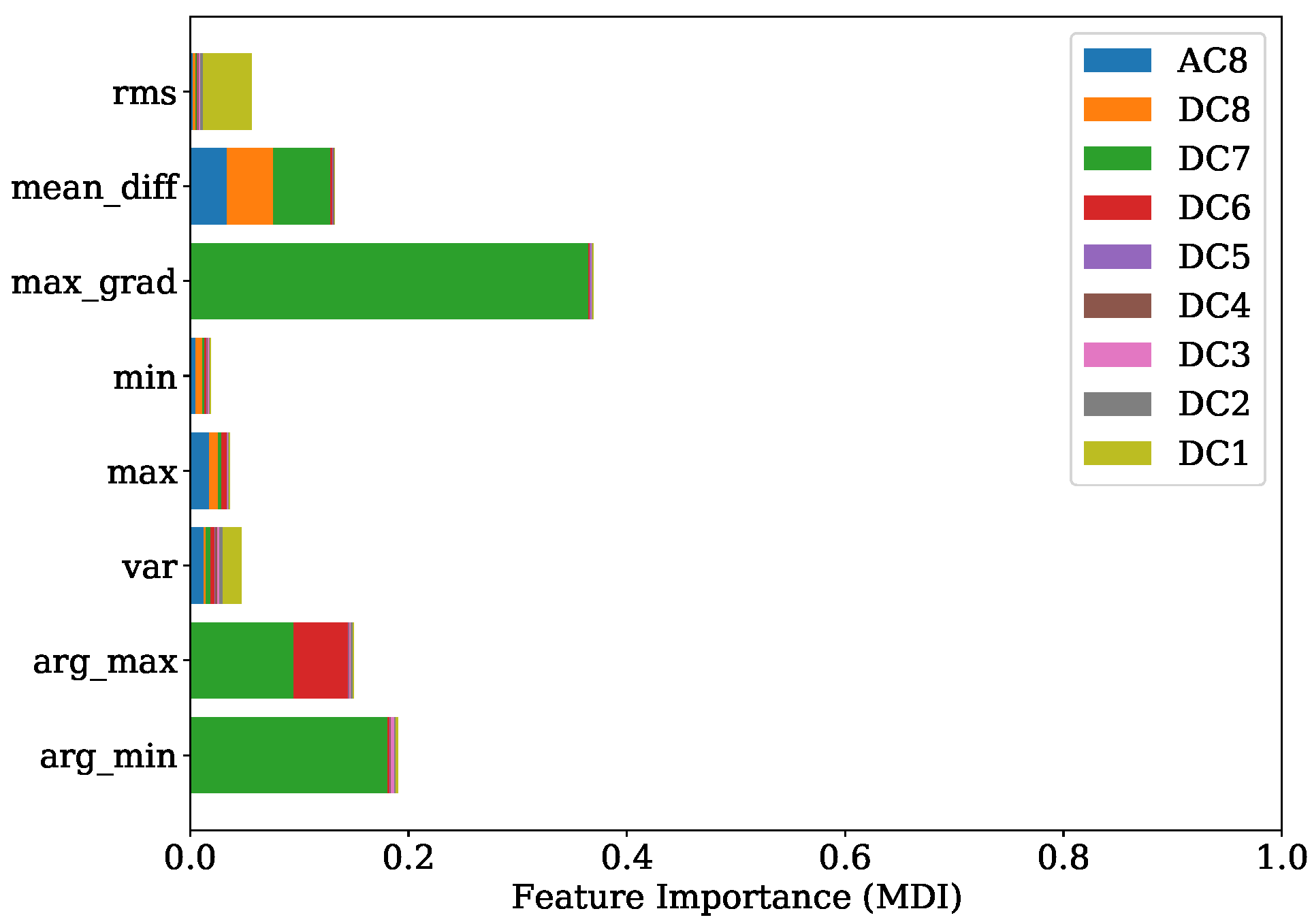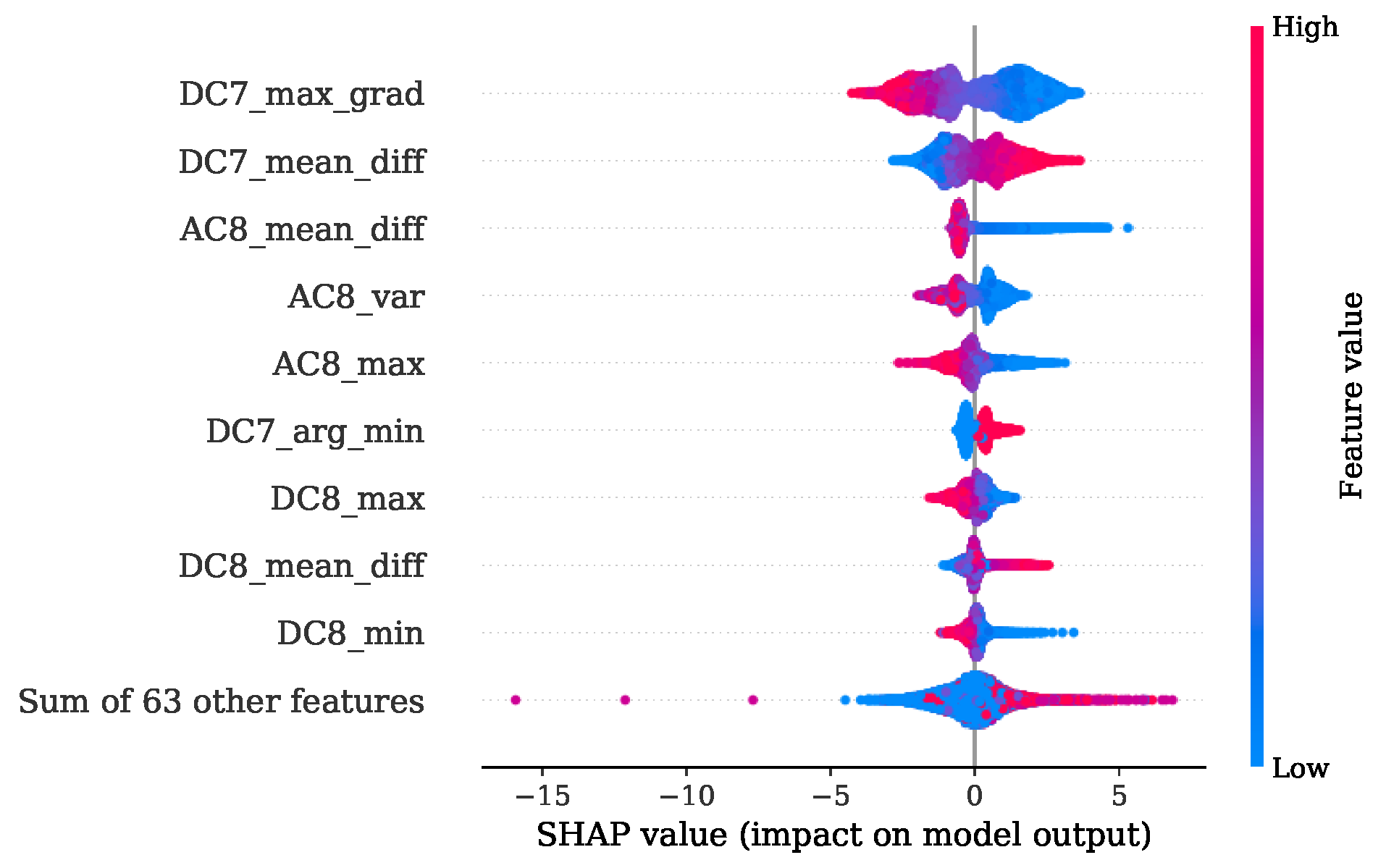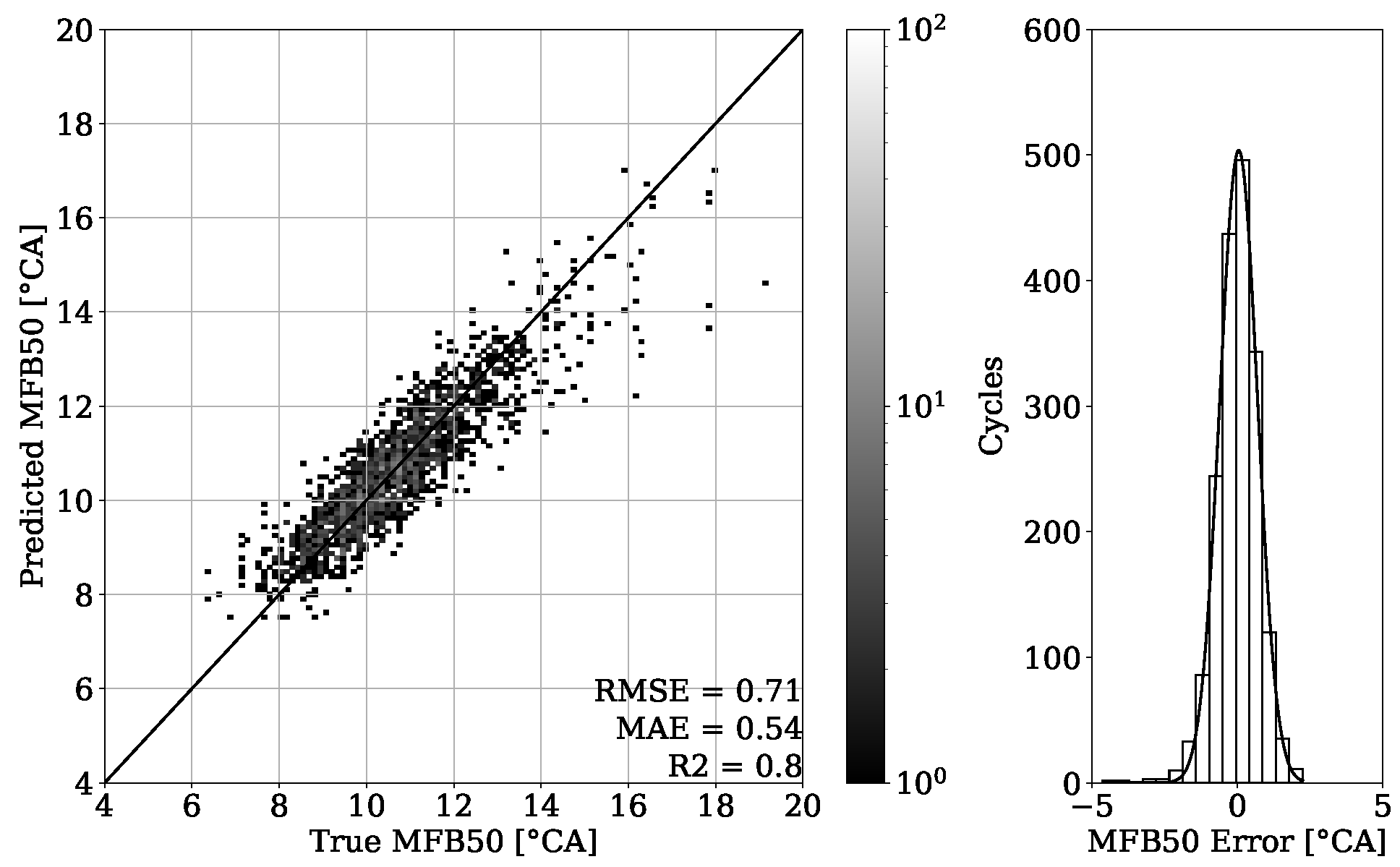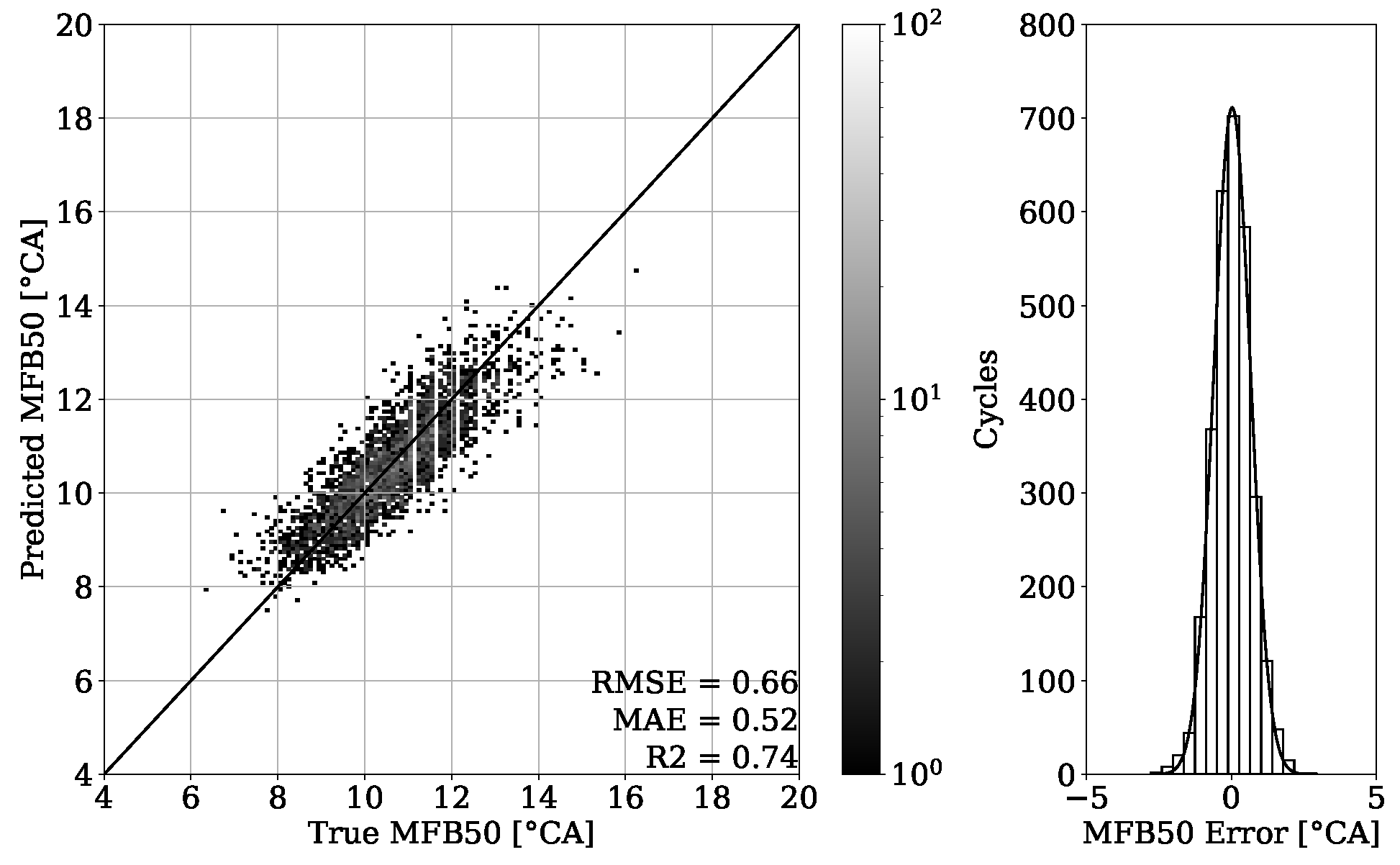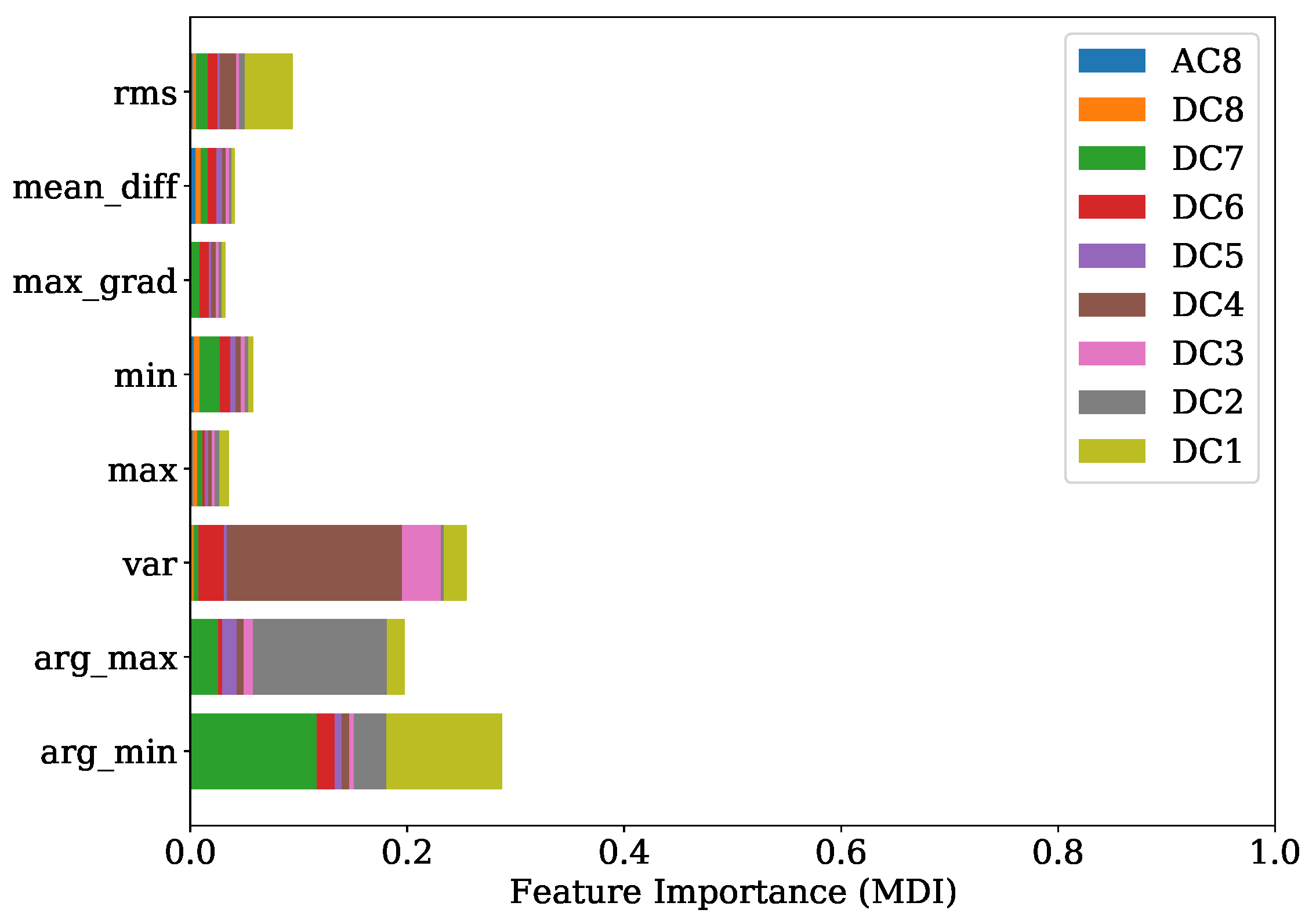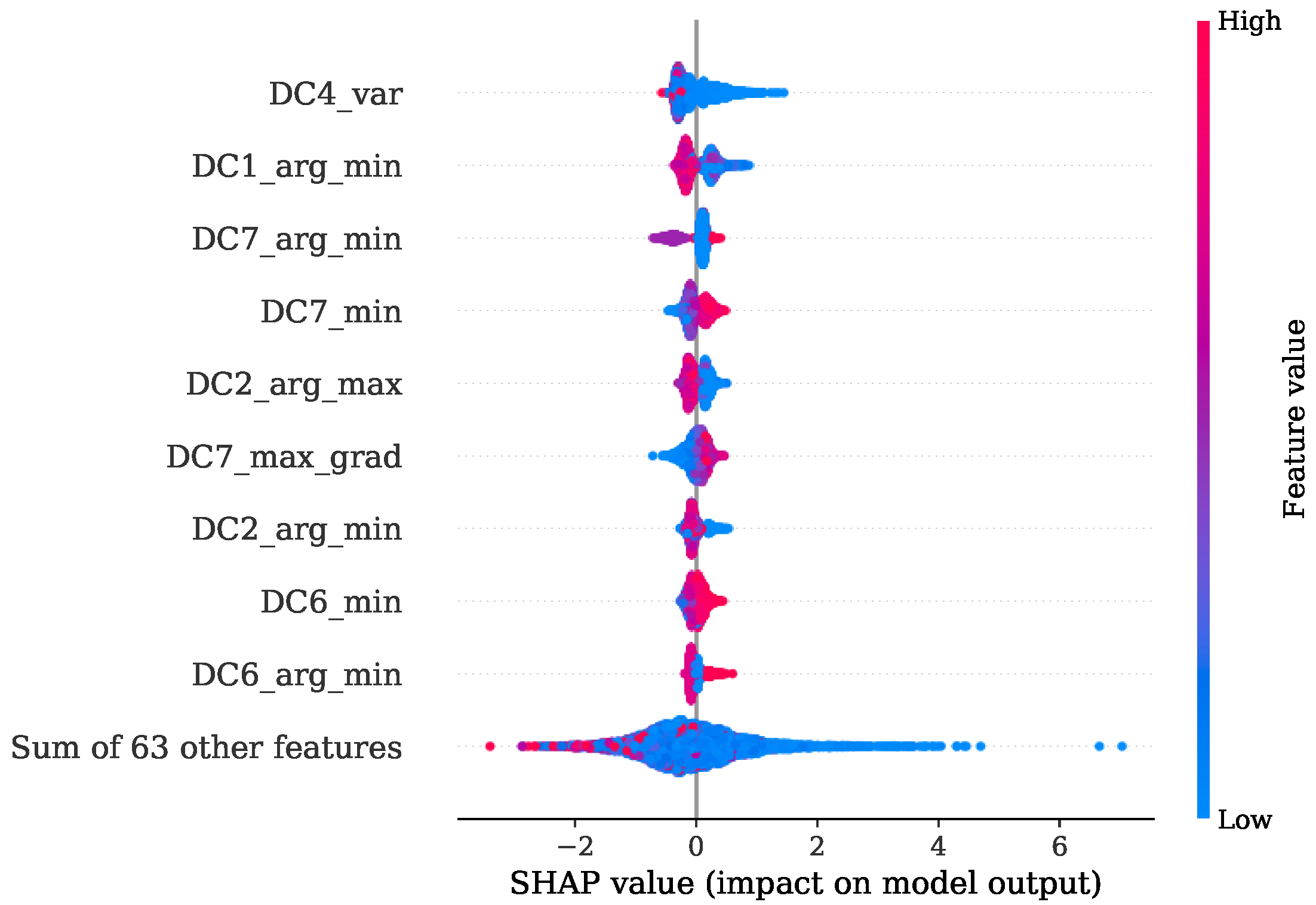1. Introduction
Since the invention of the internal combustion engine, the in-cylinder pressure measurement was fundamental for the research and development of reciprocating engines on a global scale. Closed-loop control purposes, calibration, monitoring, diagnosis and validation of numerical modelling are tasks that depend on such measurements. A combustion analysis can be performed to reduce emissions and fuel consumption and improve performance based upon the in-cylinder pressure measurements [
1]. Despite the accurate indication, these intrusive pressure sensors (PSs) have the disadvantages of high cost and issues with their durability [
2,
3,
4]. In addition, the cylinder head requires modifications for the installation of these sensors, making the mounting process complex [
1].
With the improved computational capability of the engine control units (ECUs), model-based replacement strategies for the in-cylinder PSs have become an interesting tool for engine control [
5]. Empirical predefined approaches utilizing a Wiebe function for the determination of the mass fraction burned rate have been proposed [
6]. These models require calibration for every engine operating condition.
The concept of virtual sensors can also be used to estimate combustion characteristics or even reconstruct the whole in-cylinder pressure from different source signals combined with various modelling approaches. In the study of Posch et al. [
7], it was shown that a successful correlation build up was achieved with the use of the KS signals in addition to the intake manifold pressure measurements combined in a simple differential equation. In Wang et al. [
8] such a virtual sensor was conceptualized by the use of extended Kalman filtering (EKF) and Frequency-Amplitude-Modulation Fourier series. Another approach was developed by Businaro et al. [
9] in which it was shown that the first derivative of the in-cylinder PS is closely related to the vibration signal measured by a KS. A recursive in-cylinder pressure estimation method was implemented by Han et al. [
10] which makes use of a Kalman filter and the vibration signal to gain information of the in-cylinder pressure. In Pla et al. [
2], an extended Kalman filter is used to improve the estimation of the chosen physical models in order to receiving a more accurate estimation of in-cylinder pressure. Siano et al. [
11] used a non-linear regression technique for the estimation of peak firing pressure (PFP) and its location with the filtered KS signal as input and the extraction of distinctive features. In recent years, machine learning approaches have been successfully applied for model predictive control of internal combustion engines, as shown in the study of Norouzi et al. [
12]. Taglialatela et al. [
13] used the crankshaft speed measurement as input for a multilayer perceptron network to receive the PFP and its location as output quantities. In Johnsson et al. [
14], a reconstruction of in-cylinder pressure was performed based on complex radial basis function networks from vibration and speed signals. In Bennett et al. [
15], a concept was proposed that makes use of measured crank angle (CA) kinematics as input for a recurrent neural network which approximates the in-cylinder pressure trace.
Discrete wavelet transform (DWT) is a multi-resolution decomposition and allows feature analysis associated with different frequency bands [
16]. The received coefficients are resolved in the time and frequency domains and are therefore suitable for the analysis of non-stationary phenomena, as they are expected to be introduced by the complex combustion processes of an engine [
17,
18]. This signal-processing technique has proven to be effective in filtering the information of interest from overlayed noise [
19]. In addition, the resulting coefficients of the DWT can be used to extract significant information, delivering a compact representation that can be used for further processing. Numerous gradient-boosting models have been applied successfully in many fields of research. They were implemented, for example, in the following areas: detecting intrusion attacks in wireless sensor networks [
20]; fault detection in heat ventilation and air conditioning systems [
21]; surface roughness prediction in high-speed milling in the metalworking industry [
22]; structural damage classification in a wind-turbine foundation [
23]; feature selection [
24]; GPS signal reception classification [
25]; and also for classification in predicting the interactions between target genes and drugs [
26]. In the study of Nishat et al. [
27], DWT was applied in combination with an XGBoost classifier for bearing fault detection of induction motors. The presented approach in this study consists of slicing the relevant part of the vibration signals acquired by a KS as input for the DWT with subsequent statistical feature extraction from the received coefficients. These features are then processed by the XGBoost models that perform various regression tasks to account for the chosen combustion parameters, which are the PFP in addition to the associated CAs at 10, 50 and 90% of the mass fraction burned (MFB10, MFB50, MFB90). The objectives of this research study are to find a convenient alternative for the in-cylinder PS that accomplishes an accurate estimation of the PFP and the MFB50. In addition, the capability of estimating the MFB10 and the MFB90 was investigated. For the fulfilment of tasks, a novel approach is presented which combines the DWT with an XGBoost regression model. In order to demonstrate the effectiveness of the proposed method, it was verified on comprehensive datasets from two different engines, proving to be robust to a change of engine block conditions.
This research article is organized in the following way: After this introduction in
Section 1, the experimental work is presented in
Section 2. Subsequently,
Section 3 gives a detailed explanation of the developed method followed by
Section 4 which reports the achieved results. After this,
Section 5 will provide a discussion and finally
Section 6 will present the conclusions.
2. Experimental Work
Experimental investigations were carried out on two spark-ignited single-cylinder research engines (SCE) with displacements of approximately 2.5 and 3 liters, operated in steady-state mode with natural gas. Multi-cylinder counterparts of these engines, with 12 to 20 cylinders, are used primarily for stationary power generation. Variations in ignition timing, excess air ratio and gas quality were performed as part of the single-cylinder engine tests, with measurements covering the entire range between misfiring and knocking to provide the broadest possible data base for developing simulation models for cycle-to-cycle variation and knocking. The two analyzed engines are designed with different pistons, a diverse bore and stroke of the cylinder, a varying compression ratio and ignition system. The connecting rod length only is preserved. For confidentiality reasons, the values for these characteristics cannot be presented.
In
Figure 1, a sketch of the exhaust side of such an SCE block is shown, where the position of the in-cylinder PS is shown in cyan color and the KS in orange color. Here,
p denotes for the pressure,
T stands for the temperature and
is the mass flow, while
a denotes for the converted engine block vibrations measured by the KS. In addition, the schematic experimental setup is provided that shows the two main supply paths for air and gas, respectively. The air is conditioned by a complex control system to meet the required temperature, boost pressure and water content. The gas composition is determined through gas chromatography. Accurate mass flow measurements are achieved via Coriolis mass flow meters. Furthermore, sensors for temperature and pressure measurements are installed throughout the entire test bed. CA-resolved pressure measurements were generated for the intake and the exhaust manifold as well as for the combustion chamber. The exhaust path is equipped with a back pressure flap to imitate a turbine of a turbo-charger and a unit for exhaust gas analysis that determines the concentration of NOx, CO, HC, O
2 and CO
2 [
28].
The in-cylinder PS applied in this study is the QC34C model of the AVL List GmbH. This intrusive, actively water-cooled PS works after the piezo-electrical principal where a directional deformation of the monocrystalline quartz crystals emits a charge that is converted by a charge amplifier to a voltage proportional to the acting force [
29]. The signals coming from this sensor will be used to acquire the target information for the underlying regression tasks. In order to ensure the correct installation of the PS, an intrusive position is required that ideally is flush-mounted to the combustion chamber [
1].
Parts of the vibrations of the engine block are caused by the combustion inside the combustion chamber and are recorded with a KS of type p/n 0 261 231 125 from Robert Bosch GmbH. This sensor is non-intrusive and works after the principle of a circular, seismic mass that counteracts the vibrations due to inertia. This mass interacts with a fixed piezo-crystalline layer that emits a specific charge in accordance with the impact force. The charge is converted by a charge amplifier to a voltage proportional to the intensity of the vibrations [
29]. The positioning of these KSs is crucial and can deliver different signals with varying signal quality. In serial applications, which consist of multiple single cylinder engines, a KS is positioned on one of the main bolts for each cylinder head. This position is parallel to the axis of the cylinder and has a certain engine block transfer function from the combustion chamber to the KS, as shown in
Figure 1. Among the advantages of this position is that it is common for most of the engines comparable to the ones investigated, since the mechanical concept comes with four large dimensioned bolts. No additional machining step for mounting of the KSs on these bolts is necessary due to the surface being already prepared with an appropriate drill included.
To provide a picture of how the acquired data of engine 1 and engine 2 was split for training, validation and testing
Figure 2 and
Figure 3 are presented, respectively. In addition, the variation of the three parameters from the used OPs, which are the ignition timing, the indicated mean effective pressure and the air–fuel equivalence ratio (lambda), are shown in
Figure 4 for engine 1 and in
Figure 5 for engine 2.
3. Methods
A cycle of a four-stroke reciprocating internal combustion engine is constituted by the intake, the compression, the power (combustion) and the exhaust stroke. Since the combustion process is of interest for the present study, a major portion of the relevant stroke was analysed. With the presented method, cyclic estimations of combustion parameters were gained only by the use of vibration data coming from a KS. This approach consists of four major steps: (i) slicing the part of the KS signal that contains the relevant power stroke information for estimating the combustion parameters closely related to the in-cylinder pressure trace; (ii) applying DWT on the window from the signal, receiving levels of approximation coefficients (AC) and detailed coefficients (DC), from which; (iii) a set of defined statistical features is extracted; (iv) these features will serve as the input for the XGBoost regression models.
Figure 6 gives an overview of the presented method.
As a comparison method, all regression experiments were performed additionally by extracting the same statistical features from the time and the frequency domains of the sliced signals. These obtained features served as input for the XGBoost models.
3.1. Combustion Parameters
Various combustion parameters have been introduced depending on the type of engine, the combustion modes and the injection strategies. In this study the PFP, the MFB10, MFB50 and MFB90 were selected. These quantities are conventionally computed from the in-cylinder pressure and are utilized as targets for the regression where the only input is the KS signal.
The monitoring of PFP is important due to its function as a critical structural constraint [
1]. In addition, this information can be used for balancing out all cylinders of multi-cylinder engines. The MFB values provide a measure for the fraction of energy released from the combustion of fuel to the total energy released at the end of the combustion process [
30]. The MFB50 parameter in particular provides valuable insights if an optimal combustion phasing occurs [
31,
32]. Furthermore, the difference of the MFB90 and the MFB10 gives an estimation of the burn duration. In general, the estimation of these MFB values is based on the calculation of the apparent heat release from the measured in-cylinder pressure using the first law of thermodynamics with single-zone assumption. This apparent heat release
with neglected wall heat transfer and blowby losses can be derived as [
1]:
In the above Equation (
1),
denotes the heat capacity ratio and is chosen as constant value of 1.32 with respect to the occurring gas temperatures. The volume
V of the cylinder is derived by the engine law of kinematics [
1]. From
the normalized cumulative sum can be calculated and the MFB values at the desired percentage can be extracted.
3.2. Sensor Signals Window
In
Figure 7 and
Figure 8, an example of a cycle is shown where the KS signal in presented in blue with the corresponding axis on the left. In addition, the in-cylinder pressure is plotted in orange with its associated axis on the right. The time range of the signals recorded from the KSs is from
to 360 °CA. Since the goal is to receive accurate estimations of combustion parameters it must be ensured that a relevant window slice is taken from the combustion stroke of the cycles. Due to a transfer function of the engine block from the combustion chamber to the KS a possible delay in the signals has to be taken into account. Diverging from the study of [
11], in which a window was chosen ranging from 20 to 80 °CA, a window ranging from
to 35 °CA was selected here. This is in accordance with to the findings of [
9]. It is of great importance to select an appropriate window of the signals that depicts the phenomena of interest and excludes irrelevant ones. Therefore, this choice is designed to exclude, for instance, the prominent clapping noise from the intake and the exhaust valves which can be observed by looking at the high-amplitude regions of the blue signal on
Figure 7. A major portion of the combustion phase with regard to the PFP is included in the window slice shown on
Figure 8.
3.3. Discrete Wavelet Transform and Feature Extraction
The main idea of discrete wavelet transform is the decomposition of a given signal into a number of levels, where each level is a time series of coefficients describing the evolution of the signal in corresponding frequency bands [
33]. There are two kinds of wavelet transforms: the continuous and the discrete one.
The continuous wavelet transform (CWT) of a signal
with respect to the wavelet function
is defined as [
34]:
where ∗ denotes complex conjugation. The term
is typically set to
for reasons of energy conservation. Thus, the normalized wavelet function is often written more compactly as:
As will be shown, the DWT accounts for less computational expense since infinite summations of discrete wavelet coefficients can be used, rather than continuous integrals as required for the CWT. With logarithmic discretization it is possible to link the scale
a to the size of steps taken between
b locations in a natural way. This discretization of the wavelet has the following form, where integers
m and
n control the wavelets’ dilation and translation respectively [
35]:
In Equation (
4),
stands for a specified fixed dilation step parameter set at a value greater than 1, whereas
is the location parameter greater than 0. The wavelet transform of the continuous signal
, using discrete wavelets as defined above is [
35]:
With the derived wavelet transform of Equation (
5) a simple reconstruction formula for the signal
is obtained by the infinite series as [
35]:
Since combustion events introduce non-stationary effects within the signals recorded by the KS, DWT is more suitable than classic Fourier analysis due to revealed information in the time and frequency domain [
16]. In initial experiments, several mother wavelets were tested and it was discovered that, for the present experimental settings, the Haar wavelets performed best. This claim is confirmed by the PFP regression results shown on
Table 1 where, according to [
27], four widely used mother wavelets were applied. The selected evaluation metrics for the results of this study are: (i) the root mean squared error (RMSE) which is defined as
; (ii) the mean absolute error (MAE) given as
; and (iii) the coefficient of determination (
) derived as
.
The number of levels obtained from DWT can be calculated as
[
36]. A sampling frequency of
kHz is derived from the rotational speed of 1500 rpm and the sampling rate of
°CA. For the selected window of the KS signal
, 400 samples are received, which yields eight levels. By applying the above-introduced DWT to the arbitrarily chosen cycle of
Figure 8, the blue coefficients are received from the KS signals with the associated blue axis values on the left, whereas the orange signals shown are acquired by the in-cylinder PS signals with the corresponding orange axis values on the right of each subplot in
Figure 9. The approximation coefficients (AC) constitute a filter where mainly low-frequency portions are passed, whereas the detailed coefficients (DC) represent the high-frequency counterpart.
In this study, various statistical features that were proposed by [
27,
37] were utilized for the present regression tasks, but only few of them proved to be necessary for obtaining a precise estimation of the desired combustion parameters with regard to the KS signals
. Thus, the obtained features presented in
Table 2 were extracted from every set of DC from the corresponding DWT level. Additionally an extraction of these features was performed from the AC of DWT level eight accounting for the low frequency basis. An illustration of this process is given in
Figure 10. Finally, an array of
features was obtained for every individual cycle. This extracted information served as input for the XGBoost regression algorithm.
Figure 9.
Resulting AC and DC from DWT of signals window.
Figure 9.
Resulting AC and DC from DWT of signals window.
3.4. Extreme Gradient Boosting (XGBoost) Regression and Feature Importance (FI)
Gradient Boosting is categorized as a so-called ensemble method, which refers to models employing multiple learning algorithms at the same time. Usually these models are decision trees that build on the principle of ensemble learning, where multiple weak learners collaborate to produce a model that performs better [
20,
24]. In particular cases, further developed gradient boosting implementations such as XGBoost may produce trained models that reach higher accuracy than artificial neural networks (ANNs) and ordinary least square regression models [
38]. The computational complexity of these models is reduced by an automatic learning of the nodes’ splitting process, as well as a good performance in distributed computation [
20]. Furthermore, the problem of overfitting was addressed by appending a regularization term
to the objective function within the learning procedure [
39], as given in Equation (
7).
In Equation (
7),
denotes the best set of parameters, whereas
is the training loss function and was defined as the commonly used mean squared error which is given in Equation (
8) where
are the labels and
the predictions of the model.
The regularization term is defined as Equation (
9).
Each independent tree structure and leaf weights corresponds to a and is therefore taken into account by the regularization term .
One advantage in comparison to ANNs is that the approach is simpler, meaning the tuning of hyperparameters and training is fast and can be easily performed by grid search and k-fold cross validation. In general, the amount of data required for successful training can be smaller compared to ANNs. Furthermore, the computationally efficient implementation of XGBoost makes such an approach lucrative. By utilizing a grid search on the present training sets and choosing a 5-fold cross validation, a set of optimized hyperparameters was obtained. These are: a maximum depth of five; a learning rate of 0.1; 5000 estimators; and a subsample of 0.8. To prevent overfitting, an early stopping was applied by choosing 100 rounds.
An improved understanding of the decision-making mechanism of an ML model is an important task to ensure fairness, robustness and causality while attaining the best prediction [
40]. In the present study, two techniques were applied to provide a picture where the useful information is located. The first one is the FI based on mean decrease in impurity (MDI), which is defined as the total decrease in node impurity averaged over all trees of the ensemble [
41]. For every feature
n the decrease in impurity is the sum of the split gain that uses this feature. This split gain constitutes the amount of decrease in impurity with regard to the split [
40]. The results obtained from this analysis are colored and stacked bar plots that show the distribution of FI according to the MDI across the selected features. The second technique is based on the Shapley additive explanations (SHAP). These SHAP values are calculated by introducing the features, one at a time, into a conditional expectation function of the model’s output and attributing the change produced at each step to the feature that was introduced. Finally, an averaging of this process over all possible feature orderings is performed. This measure has proven to be accurate and consistent [
42].
6. Conclusions
The investigation of representative datasets from two measurement campaigns of different engines yielded that, in both cases, the estimation of combustion parameters was successful. The proposed method proved to be able to separate useful information from noise with the signal-processing technique known as DWT. By extracting selected statistical features from the coefficients received by the DWT and using these features as input for XGBoost regression models an estimation of the selected combustion parameters PFP, MFB10, MFB50 and MFB90 was obtained.
The PFP regression reached an MAE of bar for the validation set of engine 1 and an MAE of bar for unseen OPs of the corresponding test set. Experiments of the second dataset from engine 2 revealed an MAE of bar on the validation set and an MAE of bar on unseen OPs from the test set. The MFB50 regression of engine 1 data performed with an MAE of °CA on validation set and an MAE of °CA for unseen OPs of the test set. In comparison, an MAE of °CA for validation and an MAE of °CA for testing were obtained from engine 2 data.
The presented approach shows the promising potential of replacing the expensive and not-durable in-cylinder PS with a low-cost KS. This method has the capability of dealing with KS positions not necessarily located in proximity of the combustion chamber. With this property, no additional machining steps are required, and the mounting of the sensors is easily performed. Furthermore, only one source of information alone the signals from the KS is sufficient to achieve a precise estimation of the desired combustion parameters. A further advantage is that no calibration of filters is necessary for the successful implementation of the presented method. Since the sources of useful information were identified with the FI based on MDI and confirmed by the SHAP value analysis, the potential of reducing the complexity for individual regression tasks by preserving most of the efficiency is given.
Future research steps constitute the collection and comparison of various methods from the literature for in-cylinder pressure reconstruction and estimation of combustion parameters using KS signals. Furthermore, the implementation of the presented approach on an ECU for a closed-loop control strategy will be investigated.
